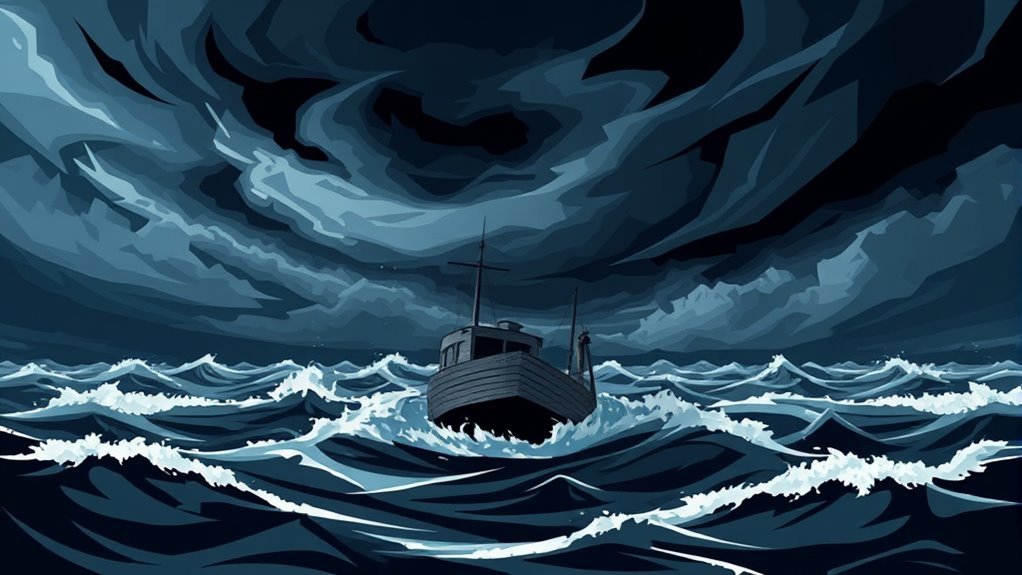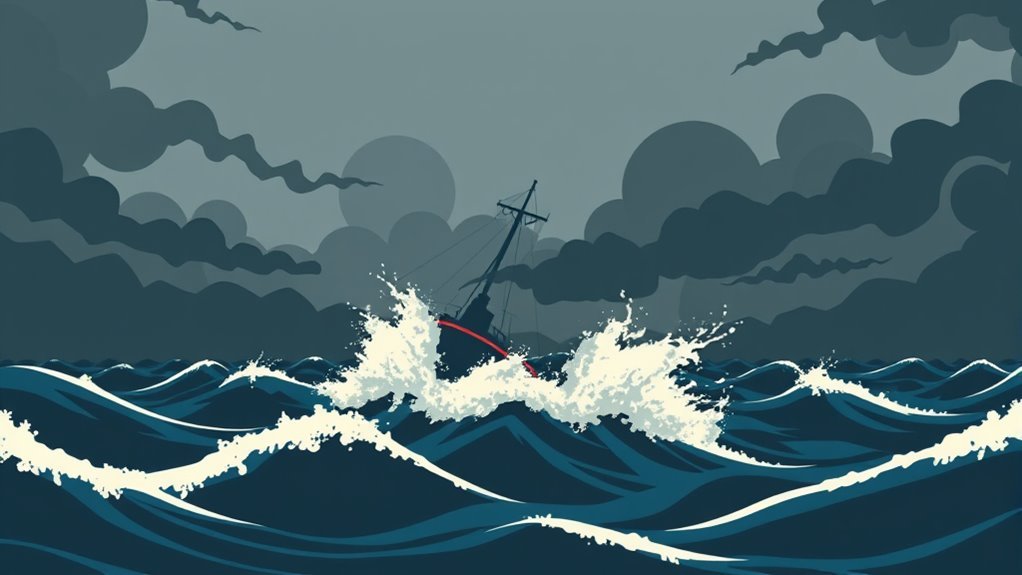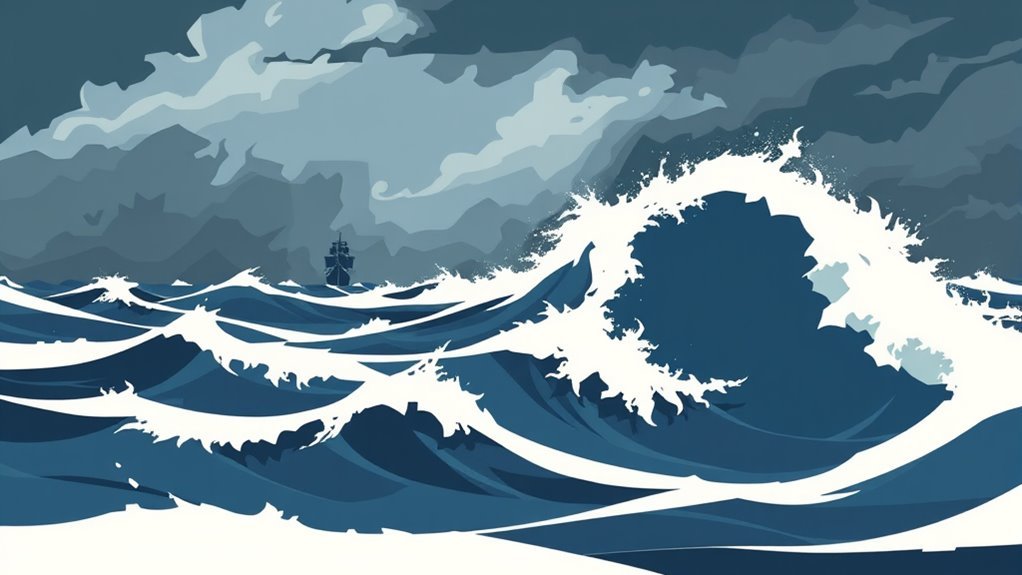Maritime history is marked by devastating squalls that underscore the need for preparation and resilience. The Great Storm of 1703 destroyed ships and claimed thousands of lives, prompting calls for better safety measures. The 1780 hurricane remains the deadliest, with 20,000 fatalities. These events led to advancements in weather forecasting and crew training, emphasizing accountability and readiness. Lessons from these catastrophic storms continue to shape current maritime practices and highlight the ongoing challenges sailors face amidst nature's fury.
Main Points
- The Great Storm of 1703 highlighted the urgent need for improved maritime safety measures following widespread destruction and loss of life.
- The 1780 Squall's devastation led to changes in population distribution and economic practices among survivors, emphasizing the long-term impact of such disasters.
- The 1847 North Atlantic Squall underscored the necessity of thorough weather training and robust emergency protocols for sailors.
- Typhoon Cobra in 1944 demonstrated the importance of accurate weather forecasting in naval operations to enhance fleet safety.
- The Perfect Storm of 1991 reinforced the unpredictability of squalls, stressing the need for accurate forecasts and preparedness strategies.
The Great Storm of 1703: A Test of Endurance
The Great Storm of 1703 stands as one of the most ferocious storms in British maritime history, claiming the lives of thousands and wreaking havoc across the terrain. Occurring from November 26 to 27, the storm released winds exceeding 120 miles per hour, causing monumental destruction.
Coastal areas faced unyielding waves that battered ships and shorelines, leading to the capsizing of numerous vessels. Survivors recounted the terror as they witnessed trees uprooted and roofs torn from buildings. The storm claimed the lives of sailors, merchants, and civilians alike, disrupting trade and livelihoods.
In London, the Thames overflowed, flooding the streets and exacerbating the chaos. The aftermath revealed a scene of devastation, prompting discussions on the need for improved maritime safety measures.
In the end, the Great Storm of 1703 served as a grim reminder of nature's power, testing human endurance and resilience in the face of catastrophic events.
The Squall of 1780: The Deadliest Hurricane in History

The Squall of 1780 stands as a critical event in maritime history, marking the deadliest hurricane on record.
Its historical impact necessitates an assessment of the devastation it wrought on communities and maritime operations.
Moreover, the responses to this catastrophic event highlight the survival and resilience strategies that emerged in its aftermath.
Historical Impact Assessment
Devastation marked the Squall of 1780, an event that remains etched in the annals of maritime history as the deadliest hurricane recorded. Its historical impact assessment reveals noteworthy consequences that reshaped both human and ecological terrains.
The storm claimed an estimated 20,000 lives across the Caribbean, highlighting the vulnerabilities of coastal communities. Additionally, it caused extensive damage to infrastructure and economies:
- Destruction of Shipping: Hundreds of ships were lost, crippling trade routes and local economies.
- Ecological Disruption: The hurricane altered ecosystems, affecting flora and fauna in the impacted regions.
- Socioeconomic Shifts: The aftermath led to changes in population distribution and economic practices, as survivors sought safer locations and new livelihoods.
These elements underscore the deep and lasting effects of the Squall of 1780.
Survival and Resilience Strategies
Survivors of the Squall of 1780 faced immense challenges in the wake of the hurricane's catastrophic impact. With entire communities devastated, the immediate priority was securing shelter and food. Resourcefulness became essential; survivors salvaged materials to rebuild homes and utilized available resources for sustenance.
Collaboration among neighbors nurtured a sense of community resilience, as individuals shared supplies and labor.
Long-term survival strategies emerged, emphasizing the significance of disaster preparedness. Education on weather patterns and emergency protocols became crucial, equipping future generations to respond effectively.
Additionally, the establishment of local support networks aimed to provide psychological and emotional assistance. Through these strategies, the survivors not only rebuilt their lives but also laid the groundwork for enduring resilience against future calamities.
The 1847 Squall in the North Atlantic: A Lesson in Preparedness
As sailors steered through the North Atlantic in 1847, they encountered a sudden and fierce squall that would serve as a stark reminder of the ocean's unpredictability.
This violent storm caught many unprepared, resulting in capsized vessels and loss of life. The event emphasized the critical importance of maritime readiness.
To prevent similar tragedies in the future, sailors and ship captains began to adopt more rigorous preparedness measures, including:
- Thorough Weather Training: Understanding weather patterns became essential for anticipating squalls.
- Robust Equipment Checks: Regular inspections of sails, rigging, and lifeboats guaranteed that vessels were ready for harsh conditions.
- Emergency Protocols: Establishing clear action plans for storms helped crews respond effectively when danger arose.
The 1847 squall consequently became a crucial lesson in the necessity of preparedness, forever altering how sailors approached the unpredictable nature of the sea.
The Typhoon of 1944: Naval Disasters in the Pacific

In June 1944, a catastrophic typhoon struck the Pacific theater, leading to one of the most devastating naval disasters in World War II history. This storm, known as Typhoon Cobra, wreaked havoc on the U.S. Navy's Third Fleet, which was caught unprepared while conducting operations near the Philippines.
The typhoon's unyielding winds and towering waves capsized several ships, resulting in the loss of over 800 sailors and numerous vessels, including the destroyer USS Hull and the escort carrier USS Midway.
The disaster underscored the critical importance of accurate weather forecasting and preparedness for naval operations. It also highlighted the vulnerability of even the most powerful fleets to nature's fury.
In the aftermath, the U.S. Navy reevaluated its operational protocols and improved its weather reconnaissance capabilities, ensuring that future fleets would be better equipped to face such extreme conditions. The lessons learned from Typhoon Cobra have remained relevant in naval operations ever since.
The 1998 Hurricane Georges: Squalls and Their Aftermath

Despite the advancements in meteorological technology, Hurricane Georges in September 1998 demonstrated how unpredictable and destructive nature can be.
Originating in the Caribbean, the storm posed considerable risks to maritime operations, leading to catastrophic consequences for both vessels and coastal communities.
The aftermath of Hurricane Georges highlighted several essential lessons:
- Preparation and Response: The need for improved preparedness measures for maritime entities facing severe weather events.
- Real-time Communication: Enhanced communication systems are vital for timely updates and coordination among vessels, ports, and emergency services.
- Environmental Impact Awareness: Understanding the long-term ecological effects of hurricanes on marine environments is important for future restoration efforts.
Ultimately, Hurricane Georges served as a stark reminder of nature's power, urging the maritime industry to modify and evolve in response to such formidable threats.
The Perfect Storm of 1991: Nature's Fury Unleashed
The Perfect Storm of 1991, often referred to as the "Halloween Storm," exemplified the devastating intersection of multiple weather systems, leading to unparalleled chaos at sea.
This extraordinary meteorological event resulted from the convergence of a powerful nor'easter, Hurricane Grace, and remnants of a tropical storm. The combination intensified the storm's winds and waves, creating monstrous conditions that caught mariners off guard.
Notably, the fishing vessel Andrea Gail became tragically emblematic of the storm's fury, as it was lost with all hands during the storm.
The storm generated waves exceeding 30 feet, emphasizing the dangerous nature of maritime navigation during such extreme weather.
The Perfect Storm underscored the critical importance of accurate weather forecasting and the need for heightened awareness among sailors.
Its legacy remains a stark reminder of nature's overwhelming power and the vulnerabilities intrinsic in oceanic endeavors.
Modern Squall Challenges: Adapting to an Unpredictable Ocean
As weather patterns continue to shift due to climate change, sailors face increasingly unpredictable squall conditions at sea.
These modern squalls present unique challenges that demand flexible strategies, as the ferocity and suddenness of storms can catch even seasoned mariners off guard. Recognizing these challenges is essential for ensuring safety and operational efficiency.
- Rapid Intensity Changes: Squalls can escalate from mild to severe within minutes, making timely decision-making imperative.
- Technological Reliance: Advanced weather forecasting tools and satellite imagery are critical for anticipating squall formation, yet they can be unreliable.
- Crew Training: Continuous education on emergency protocols and squall preparedness is necessary to equip crews with the skills to react effectively.
In facing these challenges, the maritime community must prioritize innovation and resilience, ensuring that sailors are prepared for the unpredictable nature of the ocean.
Common Questions
What Technology Is Used to Predict Maritime Squalls Today?
Today, advanced technology for predicting maritime squalls includes satellite imagery, Doppler radar, and numerical weather models. These tools improve forecasting accuracy, allowing mariners to prepare for sudden weather changes and enhance safety at sea.
How Do Squalls Differ From Hurricanes and Typhoons?
Squalls are short-lived, intense windstorms typically associated with thunderstorms, while hurricanes and typhoons are large, organized weather systems that last longer and can cause widespread damage due to their sustained winds and heavy rainfall.
What Are Some Historical Maritime Safety Improvements Post-Squalls?
Historical maritime safety improvements post-squalls include upgraded weather forecasting technologies, stricter vessel design regulations, improved crew training, and the establishment of international safety protocols, all aimed at minimizing risks associated with sudden and severe weather events at sea.
Are Certain Regions More Prone to Squalls Than Others?
Certain regions, particularly tropical and temperate zones, are more susceptible to squalls due to their climatic conditions. Coastal areas and those near large bodies of water often experience sudden, intense weather changes, increasing squall occurrences.
How Have Squalls Impacted Maritime Laws and Regulations?
Squalls have considerably influenced maritime laws and regulations, prompting stricter safety protocols, improved weather forecasting requirements, and augmented vessel design standards. These developments aim to mitigate risks and guarantee better preparedness for unpredictable weather conditions at sea.

